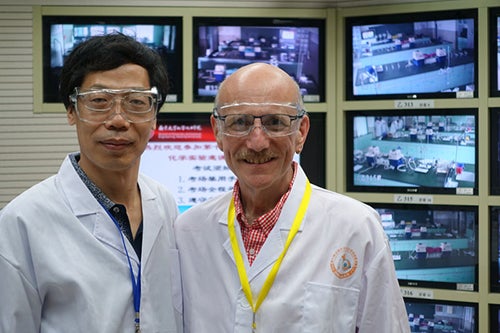
Sheffield student Amy Smith (l) and Michigan student Mike Payne (c) work on the inorganic chemistry challenge under the watchful gaze of an evaluator.
10th Biennial National Undergraduate Chemistry Laboratory Tournament (July 6-10, 2016)
“We need to do everything we can to promote excellence in experimental chemistry because only through doing the best science can we solve some of the world’s most vexing problems,” says Peking University Professor Lianyun Duan, one of the original architects of China’s National Undergraduate Chemistry Laboratory Tournament, which not only celebrated its 10th anniversary this year, but also hosted two teams of foreign student participants for the first time.
Held at the new Xianlin campus of Nanjing University from July 6-10, 2016, the competition drew teams of three students, all rising seniors, from 43 campuses all over China, as well as over 200 faculty members who held a concurrent conference to share ideas about laboratory teaching. The University of Michigan-Ann Arbor, and the University of Sheffield, UK, were invited to send teams of students who participated fully as honorary guests, but who were not included in the final ranking.
Professor Chengjian “CJ” Zhu, from Nanjing University, was one of the chief organizers of the 2016 competition. “The design of this tournament sends a powerful message about fairness, the true spirit of competition, “ says Zhu, “and getting at the underlying question of how Chinese universities are doing in the laboratory education of their students. Another intent we have for this tournament is to continue to encourage our best students to pursue their scientific career interests. ”
When I heard about the design of this tournament from CJ, a few years ago, I knew I just had to be there to see this in action. He graciously invited me to keynote the opening, and was the driver behind inviting the two teams of foreign students.
The tournament’s design is noteworthy and not something we would likely see being used in the United States. The teams are selected at random, from a large list of candidates sent in by each school, and the laboratory assignments on which they are tested are also assigned at random (and only 30 minutes before the actual competition). Students are kept anonimous throughout the competition so that bias about the school of origin is eliminated.
The foreign students had an appropriately eye-opening experience.

Chengjian “CJ” Zhu and me, standing in the central control room of the Nanjing University teaching laboratories.

